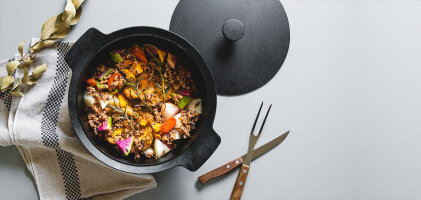Tamago recipe - on the trail of the Japanese egg

The Japanese word Tamago (卵 – たまご) translates to 'egg'. In Japan's traditional cuisine, it serves as a foundational ingredient in many dishes. From breakfast to dinner, it accompanies in classic recipes throughout daily life. As an excellent source of protein, it is not only nourishing but also enriches with its distinctive flavor.

Recipe in this blog post:
Breakfast in Japan - fortification for the day
In the classic Japanese cuisine, icy dishes already greet the plates early in the morning. There are many recipes. Whether raw mixed with breakfast rice and seasoned with soy sauce as Tamago Kake Gohan, as silky egg custard (Chawanmushi), or in pancakes (Okonomiyaki). The rolled omelette (called Tamagoyaki or Onsen Tamago) is particularly popular. These dishes are served as accompaniments to rice, miso soup, fish (e.g., salmon or tuna), vegetables, and occasionally Natto (fermented soybeans, often served with mustard and soy sauce). Green tea is also served – the Japanese start to the day reflects an image of health and richness.
Many classics have, however, disappeared from the morning scenes of modern Japan, as time has become more limited with the influx of Western values. International breakfast traditions are the new trend. Toast with jam, ham sandwiches, cornflakes, and yogurt – societal changes at the breakfast table and a quick start to the day with (dairy) coffee, orange juice, and the like. However, the Japanese omelette has been preserved, as its preparation is simple and quick.

Tamagoyaki - refueling at lunchtime and afterwards
Already feeling exhausted, it's time for lunch. In pursuit of energy, people in Japan rush into their break. The goal is to find inner calm in the bustling and crowded atmosphere and gather strength anew. Sushi is universally popular here. Tamago Sushi, Tamago Nigiri, or Tamago Maki – delicious snacks from the bento box make their way into hungry stomachs, providing satisfaction without creating a sense of fullness. Those rushing to a restaurant may indulge in the diverse ingredient in the classic Ramen, where Ajitsuke Tamago embellishes the most delightful noodle soup variations as a topping. Breakfast classics can also be found again on the menu. Tamagoyaki, as a layered, sometimes still raw omelette, enhances lunchtime. Sweet enthusiasts also enjoy eggs in desserts, for example, the delicious Castella or juicy Kasutera sponge cake.
For those who don't indulge too much, they move on lightly and satisfied towards the evening – after eating is before eating, with eggs always in the mix.
Chopstick art and its helpers
For those who eat with chopsticks, bite-sized pieces with a relatively firm consistency are needed. Therefore, the Japanese omelette is often rolled and cut into appropriately sized bites. Prepared in a pan, the round edges are cut off, similar to sushi rolls, to create aesthetic uniformity. This way, Tamagoyaki and similar dishes fit much better into the bento and don't waste any space. To simplify this further, square pans are also available in Japan. In restaurants, these contribute to resource conservation by reducing waste and thereby increasing profits.
Experience tamagoyaki for yourself - one basic recipe, endless possibilities
 1 personNo. of persons
1 personNo. of persons
 ca. 20 minutesTotal Time
ca. 20 minutesTotal Time
 easyLevel of difficulty
easyLevel of difficulty
 BreakfastDish
BreakfastDish
 ca. 350kcal per portionCalories
ca. 350kcal per portionCalories
 Vegetarian
Vegetarian
 Eggs
Eggs
 Kitchenware
Kitchenware
Japanese omelette comes in many variations – daily consumption calls for variety. It is often prepared in sweet form, but savory options are not a faux pas. With the provided recipe, preparing, frying, and rolling are easy and quick.
(Sweet) Tamagoyaki rolls

|
3
eggs
|
|
1 pinch
pepper
|
|
1 pinch
salt
|
|
2 tbsp
light soy sauce
|
|
1/2 tsp
sugar
|
|
Sunflower oil or rapeseed oil
|
|
Favorite vegetables
|
|
Herbs of your choice
|

The personal touch
Attention: In Japan, Salmonella prevention involves medicating the eggs. This is not the case in Germany. You can, therefore, cook the egg completely through and secure it with small sticks after chopping. These sticks present themselves equally beautifully on the plate and eliminate the need for chopsticks or utensils. In a sustainable manner, this allows you to forgo the use of plastic cutlery, especially when 'to go,' and eliminates the need to carry your own utensils. Finally, they fit perfectly into the bento – small as they are.
Alternative: Of course, you can also add your toppings after frying. Place your desired composition on each layer just before you start rolling.
Attention: When using Dashi, transportation in a bento is only possible to a limited extent. Dishes with Tamago as a base should always be freshly prepared and consumed quickly. They taste best when hot.
In general, creativity knows no bounds with Tamagoyaki. Compose whatever you like!
Dashi broth recipe
 4 personsNo. of persons
4 personsNo. of persons
 ca. 30 minutesTotal Time
ca. 30 minutesTotal Time
 easyLevel of difficulty
easyLevel of difficulty
 main mealDish
main mealDish
 50kcal per portionCalories
50kcal per portionCalories
 Fish
Fish
 Gluten-free
Gluten-free
|
5x10cm
dried seaweed (kombu) (origin is Hokkaido, by the way)
|
|
10g
fine and coarse bonito flakes (katsuobushi)
|
|
500ml
water
|
Attention: Kombu should not be washed. The powdery white residue has the best flavor.
Attention: Kombu must not be brought to a boil, as the broth will become bitter otherwise.




























-from-the-yakiyaki-grill-pan.jpg)




